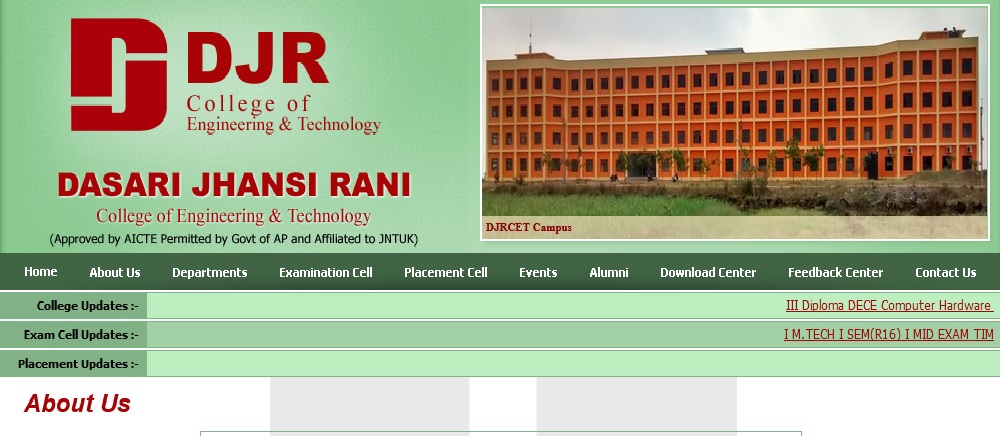RR320503 Computer Networks B.Tech Question Paper : djriet.edu.in
Name of the College : Dasari Jhansi Rani Institute Of Engineering And Technology
University : JNTUK
Department : Computer Science And Engineering
Subject Code/Name : RR320503 – Computer Networks
Year : 2008
Degree : B.Tech
Year/Sem : III/II
Website : djriet.edu.in
Document Type : Model Question Paper
Computer Networks : https://www.pdfquestion.in/uploads/djriet.edu.in/2935-RR320503-COMPUTER-NETWORKS.pdf
DJRIET Computer Networks Question Paper
( Common to Computer Science & Engineering, Information Technology, Electronics & Control Engineering, Computer Science & Systems Engineering and Electronics & Computer Engineering)
Time: 3 hours
Max Marks: 80
Answer any FIVE Questions :
Related : Dasari Jhansi Rani Institute Of Engineering & Technology Advanced Unix Programming B.Tech Question Paper : www.pdfquestion.in/2938.html
Set No. 1
All Questions carry equal marks :
1. (a) List two advantages and two disadvantages of having international standards for network, Protocols?
(b) Write short notes on interfaces and services of ISO layers. [8+8]
2. (a) The following data fragment occurs in the middle of a data stream for which the character-stuffing algorithm described in the text is used: DLE, STX, A, DLE, B, DLE, ETX. What is the output after stuffing?
(b) When bit stuffing is used, is it possible for the loss, insertion, or modification of a single bit to cause an error not detected by the checksum? If not, why not? If so, how? Does the checksum length play a role here?
(c) Data link protocols almost always put the CRC in a trailer, rather than in a header. Why? [6+6+4]

3. (a) Explain in detail the operation of slotted ALOHA.
(b) Ten thousand airline reservation stations are competing for the sue of a single slotted ALOHA channel. The average station makes 18 requests/hour. A slot is 125 µsec. What is the approximate total channel load? [8+8]
4. (a) Briefly discuss about congestion control in VC subnets.
(b) A computer on a 6-Mbps network is regulated by a token bucket. The token bucket is filled at a rate of 1Mbps. It is initially filled to capacity with 8 megabits. How long can the computer transmit at the full 6 Mbps? [8+8]
5. (a) Imagine a generalized n-army problem, in which the agreement of any two of the armies is sufficient for victory. Does a protocol exist that allows blue to win?
(b) Suppose that the clock-driven scheme for generating initial sequence numbers is used with a 15-bit wide clock counter. The clock ticks once every 100msec, and the maximum packet lifetime is 60sec. How often need resynchronization take place
i. in the worst case?
ii. when the data consumes 240 sequence numbers/min?
(c) Why does the maximum packet lifetime, T, have to be large enough to ensure that not only the packet, but also its acknowledgements, have vanished? [6+6+4]
6. (a) Briefly discuss about Concatenated Virtual Circuits.
(b) Briefly discuss about connection less Internetworking. [8+8]
7. (a) What is Nagle’s algorithm? Explain the problem of silly window syndrome: suggest a solution to this problem.
(b) What are blocking calls, primitives and non-blocking primitives? [8+8]
8. (a) What is MOSPF? Discuss briefly about Multicast Backbone.
(b) Draw and Explain the hardware architecture of a Simple set-top box. [8+8]
Set No. 2
1. (a) Briefly explain about the TCP/IP reference model.
(b) Compare and contrast OSI and TCP/IP models. [8+8]
2. (a) Imagine a sliding window protocol using so many bits for sequence numbers that wrap around never occurs. What relations must hold among the four window edges and the window size?
(b) PPP is based closely on HDLC, which uses bit stuffing to prevent accidental flag bytes within the payload from causing confusion. Give at least one reason why PPP uses character stuffing instead. [8+8]
3. (a) What is time domain reflectometry? Write about 802.3 cabling.
(b) Draw and Explain 802.3 frame format. [8+8]
4. (a) A computer on a 6-Mbps network is regulated by a token bucket. The token bucket is filled at a rate of 1Mbps. It is initially filled to capacity with 8 megabits. How long can the computer transmit at the full 6 Mbps?
(b) Briefly discuss about congestion control in VC subnets. [8+8]
5. (a) Briefly discuss about Transport Layer quality of service parameters.
(b) Briefly explain the concept of Addressing in TL. [8+8]
6. (a) Draw and explain in detail Internet Protocol Header (IPV4).
(b) Briefly discuss about IP address classes and special IP addresses. [8+8]
7. (a) Draw and explain the structure of the ATM Adaptation layer.
(b) Draw and explain the AAL1 cell format, headers and trailers. [8+8]
8. (a) Briefly explain Needham-Schroeder authentication protocol.
(b) Explain the operation of Kerberos V4. [8+8]